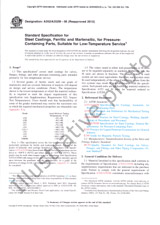We need your consent to use the individual data so that you can see information about your interests, among other things. Click "OK" to give your consent.
ASTM F290-94(2020)
Standard Specification for Round Wire for Winding Electron Tube Grid Laterals (Withdrawn 2024)
Translate name
STANDARD published on 1.5.2020
The information about the standard:
Designation standards: ASTM F290-94(2020)
Note: WITHDRAWN
Publication date standards: 1.5.2020
SKU: NS-993842
The number of pages: 6
Approximate weight : 18 g (0.04 lbs)
Country: American technical standard
Category: Technical standards ASTM
The category - similar standards:
Annotation of standard text ASTM F290-94(2020) :
Keywords:
electron tube grids, molybdenum wire, small diameter wire, UNS N02211, UNS N03300, UNS N10001, UNS R07005 ,, ICS Number Code 29.060.10 (Wires)
Additional information
| 1. Scope | ||||||||||||||
|
1.1 This specification covers round wire up to 0.006 in. (0.15 mm) in diameter for use as electron tube grid lateral winding wire. 1.2 Five classes of wire are covered based on their tensile properties (see 5.2 and 5.3). 1.3 The values stated in inch-pound units are to be regarded as standard. The values given in parentheses are mathematical conversions to SI units that are provided for information only and are not considered standard. 1.4 This standard does not purport to address all of the safety concerns, if any, associated with its use. It is the responsibility of the user of this standard to establish appropriate safety, health, and environmental practices and determine the applicability of regulatory limitations prior to use. 1.5 This international standard was developed in accordance with internationally recognized principles on standardization established in the Decision on Principles for the Development of International Standards, Guides and Recommendations issued by the World Trade Organization Technical Barriers to Trade (TBT) Committee. |
||||||||||||||
| 2. Referenced Documents | ||||||||||||||
|
We recommend:
Technical standards updating
Do you want to make sure you use only the valid technical standards?
We can offer you a solution which will provide you a monthly overview concerning the updating of standards which you use.
Would you like to know more? Look at this page.




 Cookies
Cookies
